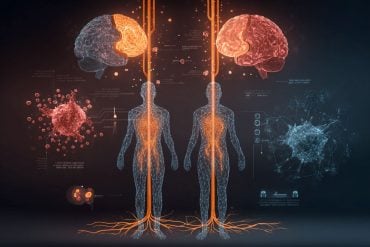Summary: A promising study reveals transplanted healthy glial cells can outcompete and replace diseased or aged brain cells, potentially restoring normal brain function. This breakthrough suggests a broad potential for the treatment of neurodegenerative diseases, such as Huntington’s disease, ALS, and some genetic schizophrenia.
The team used a unique method to humanize mouse brains, allowing them to analyze the interaction between human cells. Clinical trials on three different brain diseases are expected to begin within the next two years.
Key Facts:
- Healthy glial cells, when transplanted into humanized mice brains, can outcompete and replace both diseased and aged cells.
- This discovery opens up possibilities for treating various diseases of glial cells, including Huntington’s, ALS, and genetic schizophrenia.
- The researchers anticipate initiating clinical trials within the next two years, pending safety data on long-term cell transplants.
Source: University of Copenhagen
Uncontrollable movements, memory loss, mood changes, and forgetfulness. Those are some of the symptoms of neurodegenerative diseases in which cells in the central nervous system stop working or die.
In particular, many of these conditions are caused by disease or loss of the support cells of the brain, called glial cells. These disorders are especially challenging to treat and study because the diseased cells are in the human brain.

However, there is hope for new effective treatments. New research from the University of Copenhagen shows that the diseased and aged brain cells can be replaced with new and fresh ones, potentially helping restore normal brain function.
“When we transplant healthy human glial progenitor cells into the brains of mice that have been already colonized by diseased human brain cells, the healthy cells outcompete the sick cells. Even more remarkably, we also found that younger cells replace aged cells when transplanted into otherwise healthy brain.
“That makes the potential use of glial cell transplantation very broad, because we could go into all sorts of disease targets where we have older glial cell populations,” says Steve Goldman, who is a professor at the Center for Translational Neuromedicine at the University of Copenhagen. He is the senior author of the new study.
Glial progenitor cells can make cells called astrocytes, the support cells that protect and ensure the supply of oxygen and nutrients from blood vessels to neurons while removing waste substances, and others called oligodendrocytes, which make myelin, the insulating substance of the brain’s white matter.
Although the study was conducted in mice, the humanized brain method developed by Steve Goldman and his group allowed the examination of human brain cells in the live adult brain, making it likely that their results will apply to human patients as well.
Healthy cells outcompete diseased cells
In the study, the researchers transplanted healthy glial cells into the brains of mice already populated with diseased human glial cells.
Previously, the researchers had demonstrated the benefits of transplanting healthy human cells into mouse models of Huntington’s disease. However, since those experiments involved human cells replacing mouse brain cells, the researchers needed to prove that the same outcome would occur when replacing human cells with human cells.
“We transplanted the healthy human cells into the mice that were ‘humanized’ with the mutant Huntington-expressing glia, and the healthy glial cells outcompeted and replaced the diseased glia, actually eradicating the diseased glial population,” Steve Goldman says.
The same outcome was observed when the researchers attempted to replace non-diseased, healthy but aged glial cells with new cells. The younger cells successfully outcompeted the aged cells.
“That told us that it wasn’t just a question of healthy cells outcompeting the diseased cells of Huntington’s disease, but that this was much broader in terms of its potential use, because we could go into all sorts of disease targets where we have older or diseased glial populations. The advantage is significant in terms of where this could go because there are all sorts of diseases of glial cells,” Steve Goldman says.
That includes illnesses like multiple sclerosis and white matter stroke, and also neurodegenerative diseases like Huntington’s, ALS, and some of the genetic schizophrenias.
Treatments are only a few years off
The new research brings great perspectives for new treatments of complex diseases.
“If we can replace the diseased and aged cells, then we should be able to restore aspects of normal function in these degenerative diseases, as we have seen with our experimental models of Huntington’s disease,” says Steve Goldman, who adds:
“But that’s basically a proof of principle because we think the same thing would work in some of these other diseases as well. In ALS, some of the frontotemporal dementias, and even in some of the hereditary schizophrenias, as well as in the myelin diseases and age-related white matter loss.”
The possibility of new treatments is not far off. The researchers are already proposing clinical trials to test the effect on three different brain diseases, that include Huntington’s disease as well as two diseases of white matter, progressive multiple sclerosis and Pelizaeus-Merzbacher disease.
“Things are fairly far along. We still need to be absolutely sure of the long-term safety of the cells after we transplant them. But we are expecting to have that data in about a year and a half,” says Steve Goldman and adds:
“At that point we hopefully can get the approval to go into patients, so I would hope that we could initiate trials of this approach within two years from now.”
Funding: The research was supported with funding from the Novo Nordisk Foundation, the Lundbeck Foundation, the Olav Thon Foundation, and the Adelson Medical Research Foundation. Dr. Goldman holds additional positions at Sana Biotechnology, Inc., and at the University of Rochester.
About this neurology research news
Author: Sascha Rasmussen
Source: University of Copenhagen
Contact: Sascha Rasmussen – University of Copenhagen
Image: The image is credited to Neuroscience News
Original Research: Open access.
“Young glial progenitor cells competitively replace aged and diseased human glia in the adult chimeric mouse brain” by Steve A. Goldman et al. Nature Biotechnology
Abstract
Young glial progenitor cells competitively replace aged and diseased human glia in the adult chimeric mouse brain
Competition among adult brain cells has not been extensively researched. To investigate whether healthy glia can outcompete diseased human glia in the adult forebrain, we engrafted wild-type (WT) human glial progenitor cells (hGPCs) produced from human embryonic stem cells into the striata of adult mice that had been neonatally chimerized with mutant Huntingtin (mHTT)-expressing hGPCs.
The WT hGPCs outcompeted and ultimately eliminated their human Huntington’s disease (HD) counterparts, repopulating the host striata with healthy glia. Single-cell RNA sequencing revealed that WT hGPCs acquired a YAP1/MYC/E2F-defined dominant competitor phenotype upon interaction with the host HD glia.
WT hGPCs also outcompeted older resident isogenic WT cells that had been transplanted neonatally, suggesting that competitive success depended primarily on the relative ages of competing populations, rather than on the presence of mHTT.
These data indicate that aged and diseased human glia may be broadly replaced in adult brain by younger healthy hGPCs, suggesting a therapeutic strategy for the replacement of aged and diseased human glia.






